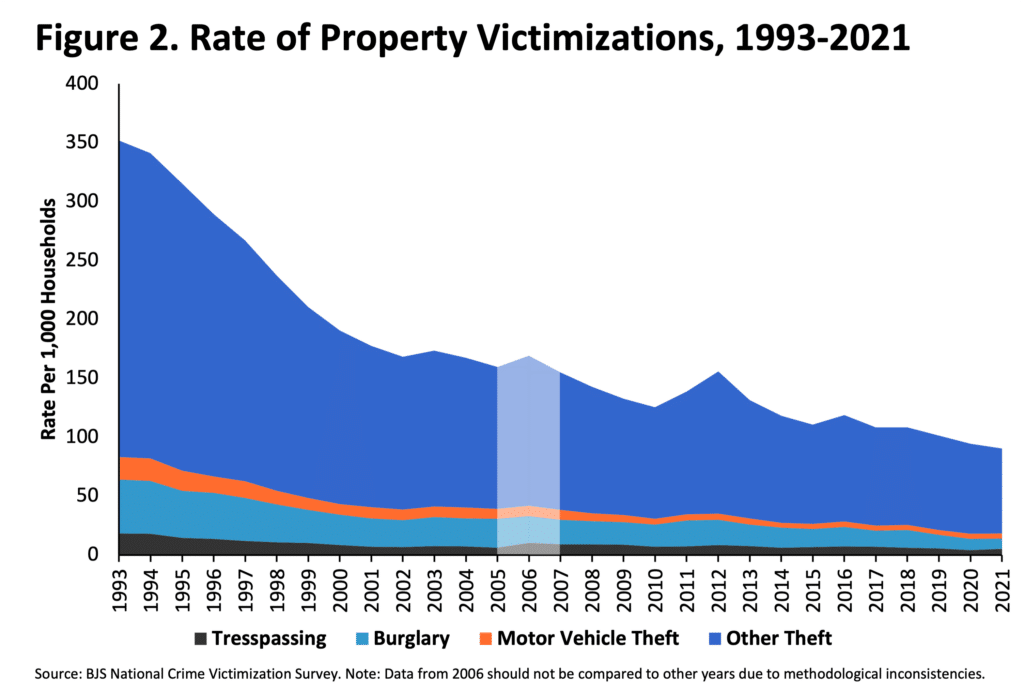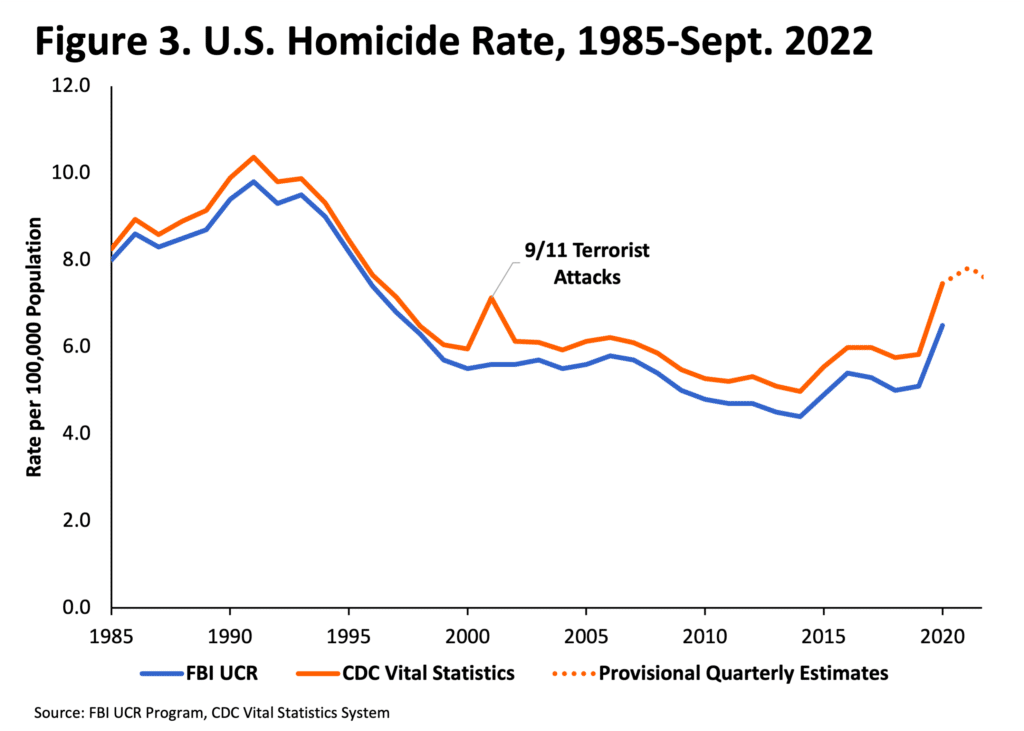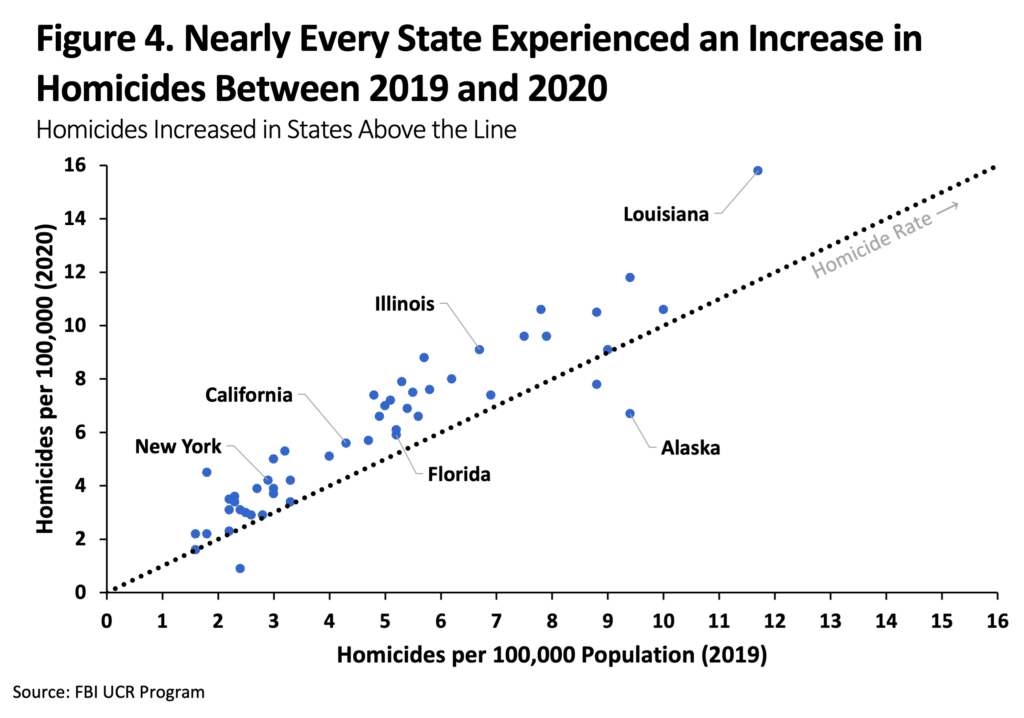In recent years, headlines have warned of a nationwide spike in crime. Crime data compiled by the Federal Bureau of Investigation revealed a nearly 30% nationwide increase in reported homicides between 2019 and 2020, the single largest year-over-year increase on record. More recent data, albeit incomplete, suggests that the homicide rate in 2023 is on track for the largest year-over-year decline on record. This is hopefully an indicator that the increase in crime isn’t a long-term trend.
Unfortunately, quality national crime statistics are lacking, so it is important to understand the context and limitations when evaluating these numbers.
First, year-over-year changes in crime data only tell part of the story and, in many ways, are a flawed way to view trends in crime. Notably, the unprecedented rise in homicides in 2020 coincided with the onset of the COVID-19 pandemic. Lockdown mandates disrupted nearly every aspect of everyday social life. Unusual crime statistics in such a time should not be unexpected. It is more informative to observe long-term trends in the crime rate. From such a perspective, violent crime, including homicide, has decreased dramatically since its peak in the 1990s.
In 2020, the violent crime rate remained near the record lows achieved throughout the 2000s. A significant decline in the homicide rate in 2023 would be consistent with the longer-term trend outside the pandemic.
Second, and perhaps more troubling, the nation lacks a timely source of quality crime statistics. The FBI’s Uniform Crime Reporting (UCR) program is one of the two primary sources of national crime statistics heavily relied upon by journalists, academics, and policy experts. The UCR enables state and local law enforcement agencies to voluntarily submit their crime data to the FBI. Counts of crimes recorded and submitted by law enforcement agencies are then weighted to account for incomplete reporting. Typically, the FBI releases year-end reports covering the previous year; for instance, the crime statistics for 2020 were released in September 2021. This delay in publication, while likely necessary for ensuring accuracy, means we lack a real-time picture of crime at the national level.
Compounding the usual problem of reporting delays, the FBI recently changed its data reporting system, and law enforcement agencies have been slow to migrate to the new system.
Since 1930, agencies could report through the Summary Reporting System, or SRS. However, in 2015, the FBI announced its official transition to the new––and much more detailed––National Incident-Based Reporting System. The SRS was phased out in Jan. 2021, but only 11,500 out of 18,000 law enforcement agencies reported data through NIBRS in 2021. Consequently, the FBI has not released national crime estimates for the years after 2020.
The other major source of national crime statistics is the National Crime Victimization Survey (NCVS) conducted by the Bureau of Justice Statistics. While the FBI estimates rely on reporting by law enforcement agencies, the BJS estimates are based on a survey administered to a representative sample of U.S. households. One advantage of NCVS is that it captures crimes that are not reported to law enforcement. According to the most recent NCVS report released in Sept. 2022, only 46% of violent crimes and 31% of property crimes were reported to police.
However, the survey design of NCVS means that homicides cannot be tracked (given that murder victims are obviously unable to respond to surveys). NCVS also tracks a slightly different set of crimes than the FBI data. Minding these caveats, the NCVS data suggest that violent crimes––excluding homicides––actually fell by 22% between 2019 and 2020. The decline was largely driven by a decrease in assaults. In 2021, the National Crime Victimization Survey found no change in violent crime at the national level.

Similar to the long-term trend in violent crime, the property crime rate has fallen steadily since its peak in the 1990s. Between 2019 and 2021, the rate of property victimization declined by 11% nationwide. The rate of motor vehicle theft increased by 10 percent between 2019 and 2020, but this difference was not statistically significant.

While NCVS does not track homicides, the Centers for Disease Control (CDC) offers an alternative set of data that includes information on homicides. The CDC data also cannot be directly compared to the FBI data, as they have distinct methodologies. While the FBI data relies on reports by law enforcement agencies, the CDC data is derived from coroners’ reports, encompassing non-criminal homicides such as cases of self-defense. Consequently, the CDC mortality data shows a slightly higher number of homicides annually compared to the FBI data. There was also a notable spike in homicide mortalities in 2001 due to the 9/11 terrorist attacks. Despite this variation, both sources generally reflect similar trends.

The CDC data also shows a large spike in homicides between 2019 and 2020. While the FBI has not released national homicide rate estimates beyond 2020, provisional estimates from the CDC data extend through the third quarter of 2022. Fortunately, these more recent estimates suggest that the homicide rate declined by about 3.8% between the third quarter of 2021 and the third quarter of 2022. A recent report from the Council on Criminal Justice featuring data from a sample of 30 American cities also suggests that the troubling rise in homicides may be beginning to wane. Moreover, AH Datalyrics crime data expert Jeff Asher has compiled data from 114 cities, indicating that homicides in those cities are down 12.2% so far this year. While these cities aren’t nationally representative, Asher estimates that the nationwide decline in 2023 could land somewhere near 10 percent. A 10% decline would be the largest on record, but even so, the homicide rate would remain elevated relative to 2019.
It’s important to recognize that the recent increase in homicides appears to be a nearly universal phenomenon. The FBI data shows that between 2019 and 2020, homicides increased in every state except Alaska, New Hampshire, and New Mexico.
As pointed out by Fordham University law professor John Pfaff, the 2020 homicide spike differs from prior violent crime waves in that it was not driven by a few cities. Almost every city experienced a rise in homicides, and any “one city’s share of homicides was roughly the same as its share in 2019, just appreciably higher.”
While it could be years before researchers determine the underlying causes of this spike in homicides during the pandemic, its universality suggests dispersed, as opposed to localized, causes. In other words, it is unlikely that particular state or local policies are responsible for the spike in crime, given that it occurred just about everywhere.

As reported in The Wall Street Journal last year, the rise in homicides in 2020 was also not limited to large cities. The CDC mortality data reveals that the homicide rate increased by 29.7% in large metros, 26.3% in medium and small metros, and 23.5% in rural areas, undermining any claim that progressive prosecutors or so-called progressive ‘soft-on-crime’ policies were responsible for the rise in homicides.
The NCVS also provides some insight into the differences between rural and urban trends. Jeffrey Anderson noted in an article for City Journal last year that the latest NCVS report indicated non-homicide violent victimization increased in urban areas but not in rural or suburban areas. However, this trend appears to be driven primarily by an increase in simple assaults. When simple assault is excluded, there was no significant change in violent crime in urban, suburban, or rural areas on average.

Without question, data points to a dramatic spike in homicides in 2020, and the homicide rate remains troublingly high compared to pre-pandemic levels. This increase warrants serious concern from policymakers, reform advocates, and the public. Yet taking crime seriously means relying on evidence-based policies informed by data. It is important to understand crime data in context and avoid reactionary policy decisions.
A more comprehensive analysis of the available data, consideration of long-term trends, and the broader context reveal a more nuanced picture of crime in the country. The decline in violent crime rates since the 1990s, despite the recent spike, indicates significant progress has been made in addressing crime. It would be a mistake to abandon that progress by dismantling successful criminal justice reforms achieved in recent years.
It could be years before the FBI begins reporting more comprehensive crime statistics. The good news is that the new and improved reporting system should be much more informative. But in the meantime, journalists, lawmakers, policy experts, and the public should use great caution when confronted with national crime statistics.

